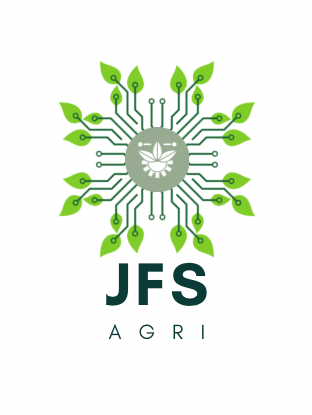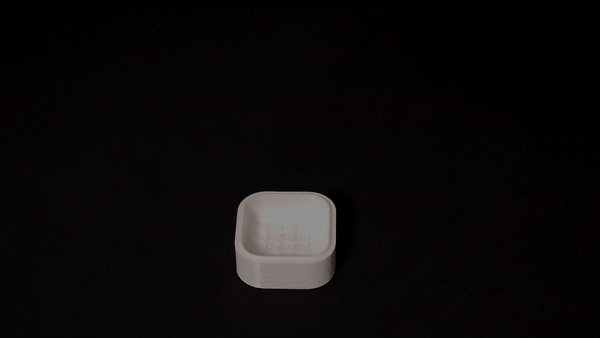BubsBuilds Projects

- Details
- Parent Category: BubsBuilds Projects
- Category: Assorted (hopefully) "Useful Stuff" Projects
Assorted connectors, brackets, and such I've made for designs using 20mm x 20mm t-slot aluminum extrusion.
Hinges/Pivots
Design gist
All of these pivots have the same basic design for the pivot mechanism. The annotated (at least technically, if you can read my hieroglyphs) cross section below shows the basics.
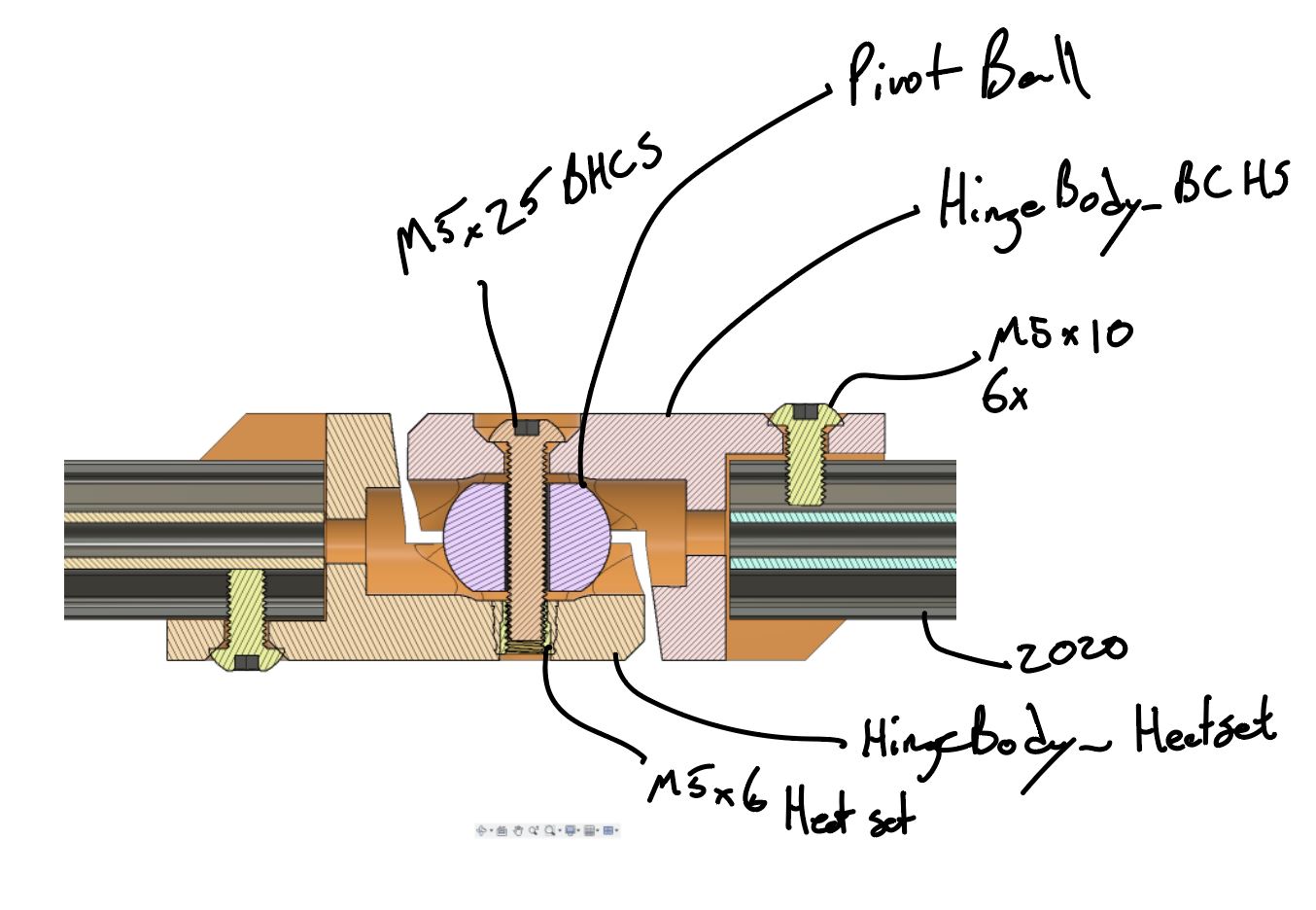
There are three main parts to the assembly, the Pivot Ball and then two Hinge Bodies. By relying on the ball pivot within the load path, the pivot can operate more smoothly even with misalignment in the 'bearing'. Although the ball pivot does smooth the movement, I wouldn't really recommend these for any sort of regular-use hinge application. While a shoulder bolt could be swapped in place of the M5x25 to make this into a more proper hinge, it would require sliding friction between printed components. Should be fine for a hinge that is only going to see occasional use.
The main differences between the below are in the Hinge Bodies, with each having different attachments to the extrusion to enable different configurations.
In-line - Single
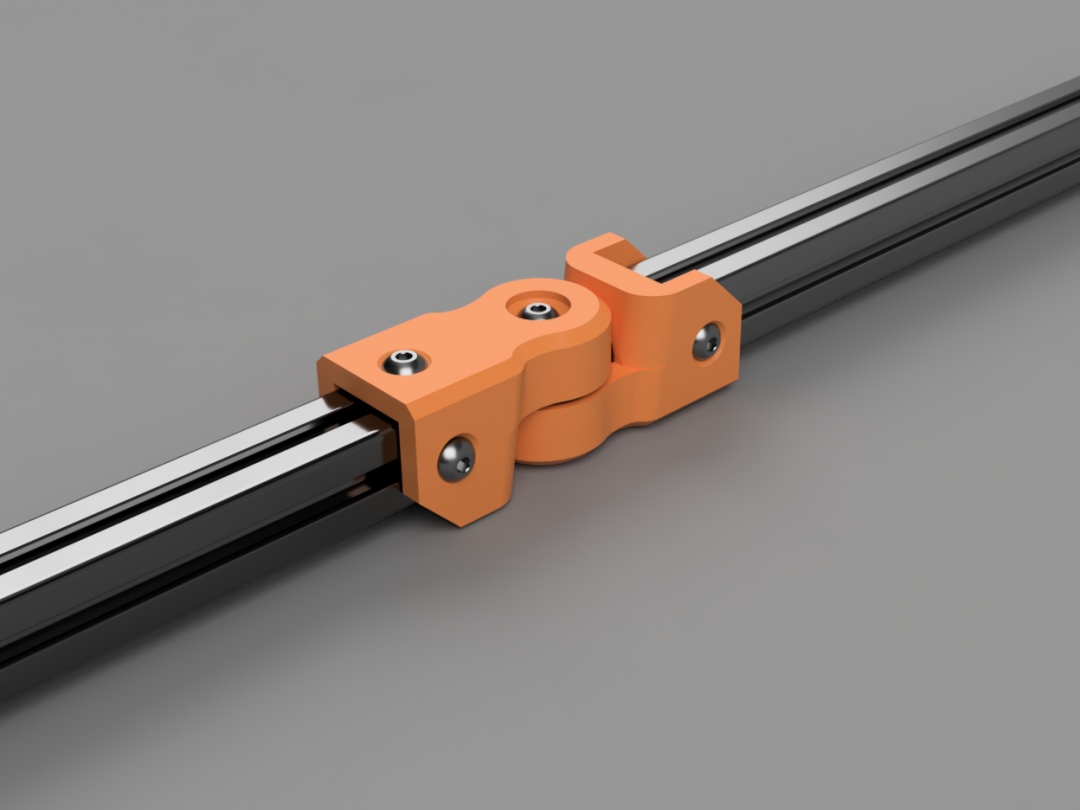 |
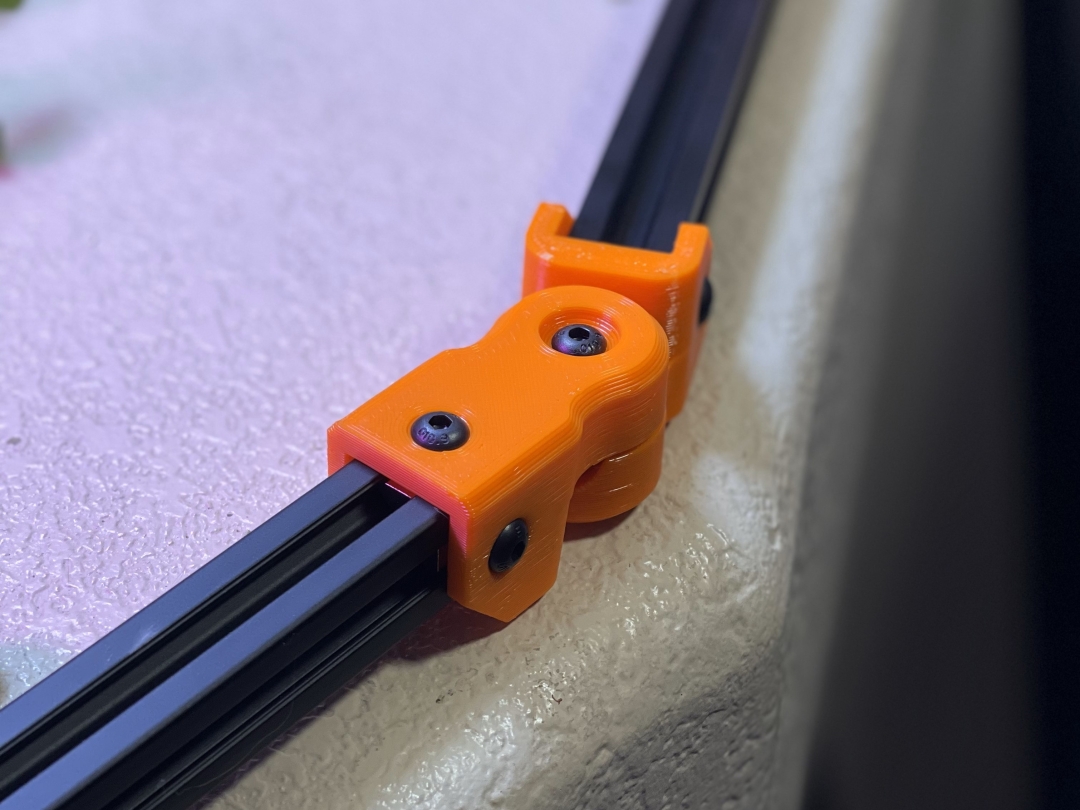 |
This is an in-line pivot and is the simplest and most compact of these hinges (at least as of when I'm writing this). It has three fastening points on each hinge body, but all of them are in the 'end' location. So this would not be an idea choice for anything that's going to be cantilevered with any appreciable load on it. Works great for a static frame that needs to have some odd angles in it. If you don't want to use heat sets (but if not, you're really missing out :) ) you can also just print two of the 'BHCS' bodies, and use an M5x30 with a nut.
In the pictured build:
- Hinge bodies and PivotBall - Printed with 0.48 layers on 0.6 nozzle in Orange Overture PETG and Black Overture PETG
- Heat set insert - M5x6 - I've been using these, but any similar option should work.
- Fasteners - I pulled mine from this kit that I've rebought a few times now.
- M5x10 (Qty 6) - These are for the attachments to the 2020
- M5x25 (Qty 1) - For through the pivot
- 2020 Extrusion - I've bought many brands and most are all pretty much the same. I've rebought this brand several times and been happy with the price/ft compared to the others, but I know that also can change any given day....yea Amazon :)
- T-nuts - I don't buy anything other than this style of T-Nut anymore. Can be dropped in, they stay put, they are available in different fastener size options....I just love them...¯\_(ツ)_/¯ hey, we've all got our thing
90 Degree
 |
 |
This one is for a hinge/pivot where the extrusion being pivoted is 'normal' to the one it is being attached to...didn't make sense? Look at the picture and you figure it out! :)
The parts and materials are all the same as the ones listed about, with the exception that the printable files can be found here on Printables.
Midspan
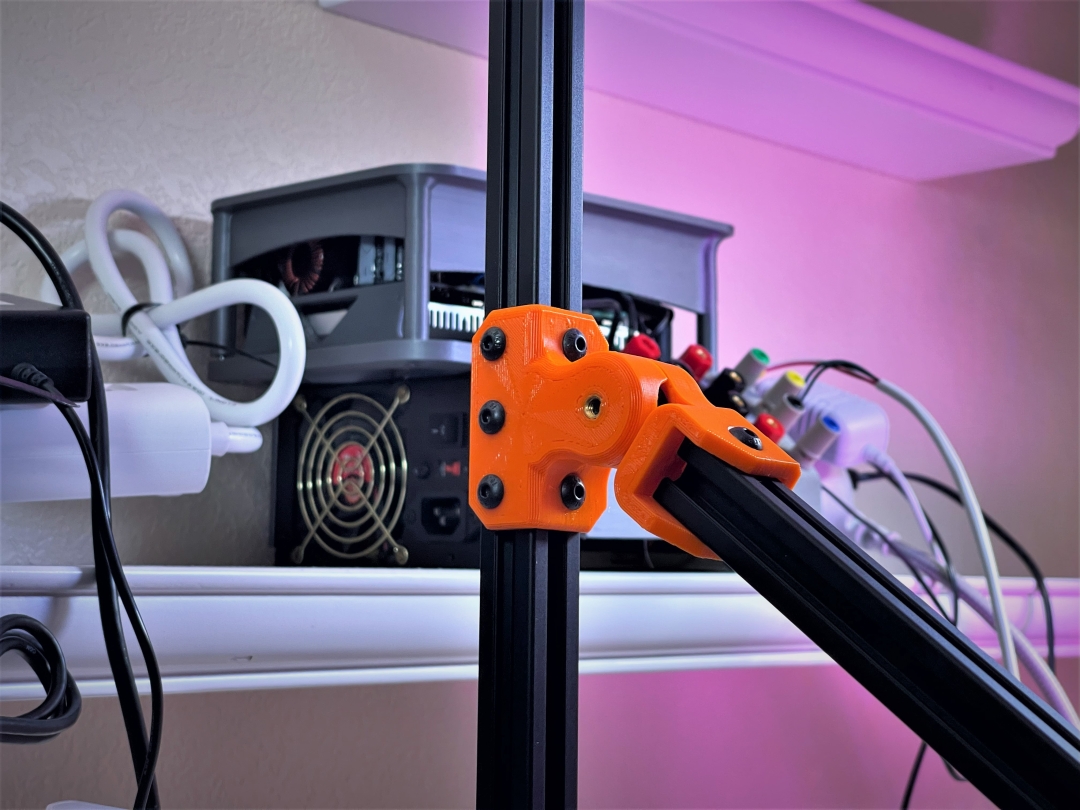 |
 |
A pivot/hinge for 2020 aluminum extrusion. The hinge is made up of three printed parts, none of which should need any supports, brims, etc. I designed it for introducing odd angles into 2020 extrusion frames. I've now made a few different variants on this pivot, this one is intended for when one frame member needs to come in at an angle, midspan of another member.
I printed mine from PETG on a 0.6mm nozzle and it takes about 2 hours for the set.
Hardware:
- HingeBody_Midspan.stl, HingeBody_BHCS.stl, and PivotBall.stl - Parts to print. I printed mine in both Orange and Black Overture PETG.
- m5x6 Heat Set insert - I used one of the 6mm lengths from this kit, but anything under 7mm length should be fine.
- m5x10 BHCS and m5 t nuts
Folding Table Hinge
Printables | Thingiverse
Details on the folding table hinge can be found here
 |
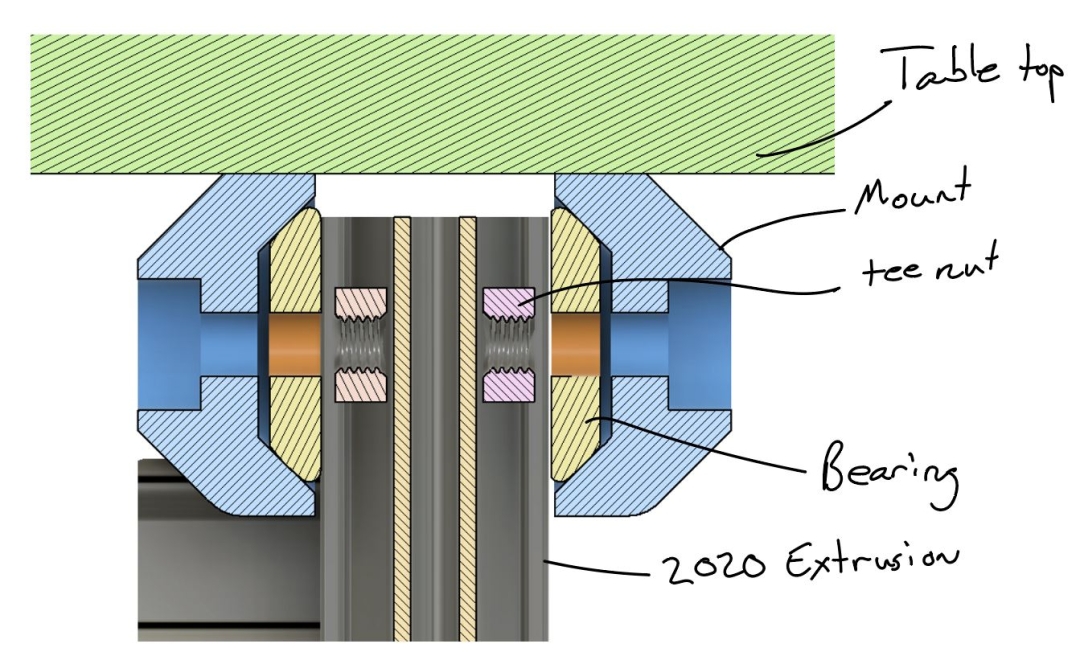 |
90 Deg Elbow
 |
 |
Just a little 90 degree elbow. Configured for at least two M5x10 fasteners per extrusion (can be three on the long side if you also add the one in the corner, as shown in the images.)
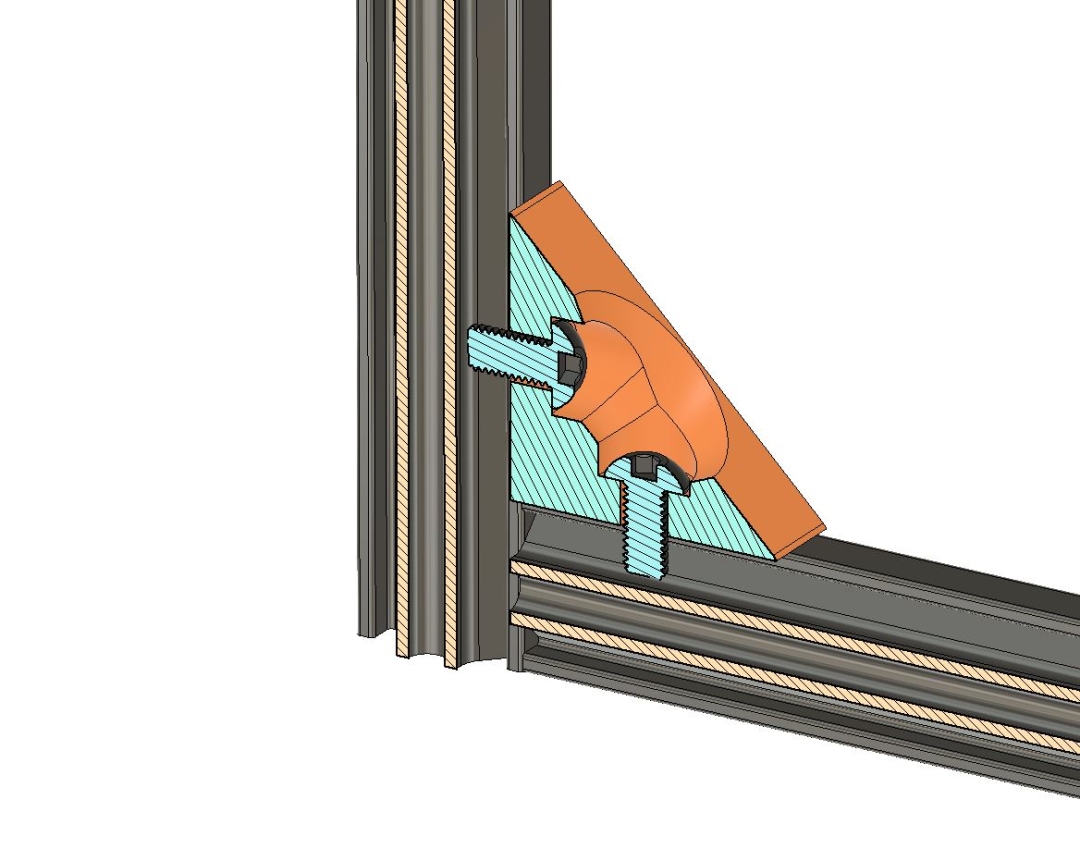
Each prints in under a half an hour (with my settings) and shouldn't need any brims, supports, etc.
Hardware pictured:
- Corner_90.stl - I printed mine from Blue Overture PETG. Full print settings in the 3mf file available on Printables et al.
- M5x10 BHCS - The 'meat' of the plastic at the bolt interfaces is 5mm thick and the holes are nominally 5.5mm diameter...deviate as you wish :)
- M5 t-nuts - I love the little spring-loaded t-nuts that are drop in (don't have to be slid in from the end) and preloaded to stay in place.
Tees
3-way Tee
 |
 |
A 3-way tee for 2020 aluminum t-slot extrusions. Provides a sturdy, square corner for frames and the like.
Each one takes about 30 min with my slice settings (0.48 layers on a 0.6 nozzle, full settings in 3mf file on Printables)
Pictured hardware
- Tee_3-way.stl - Pictured one was printed in Orange Overture PETG.
- M5x10 BHCS - Should work fine with any M5x10, but I sized it with BHCS in mind.
- 2020 Extrusion - I've bought many brands and most are all pretty much the same. I've rebought this brand several times and been happy with the price/ft compared to the others, but I know that also can change any given day....yea Amazon :)
- T-nuts - I don't buy anything other than this style of T-Nut anymore. Can be dropped in, they stay put, they are available in different fastener size options....I just love them...¯\_(ツ)_/¯ hey, we've all got our thing
4-way Tee
 |
 |
A 4-way tee for 2020 aluminum t-slot extrusions. Provides a sturdy, square corner for frames and the like.
Each one takes about an hour with my slice settings (0.48 layers on a 0.6 nozzle, full settings in 3mf file on Printables)
Pictured hardware
- Tee_3-way.stl - Pictured one was printed in Orange Overture PETG.
- M5x10 BHCS - Should work fine with any M5x10, but I sized it with BHCS in mind.
- 2020 Extrusion - I've bought many brands and most are all pretty much the same. I've rebought this brand several times and been happy with the price/ft compared to the others, but I know that also can change any given day....yea Amazon :)
- T-nuts - I don't buy anything other than this style of T-Nut anymore. Can be dropped in, they stay put, they are available in different fastener size options....I just love them...¯\_(ツ)_/¯ hey, we've all got our thing
4-way Tee - Full
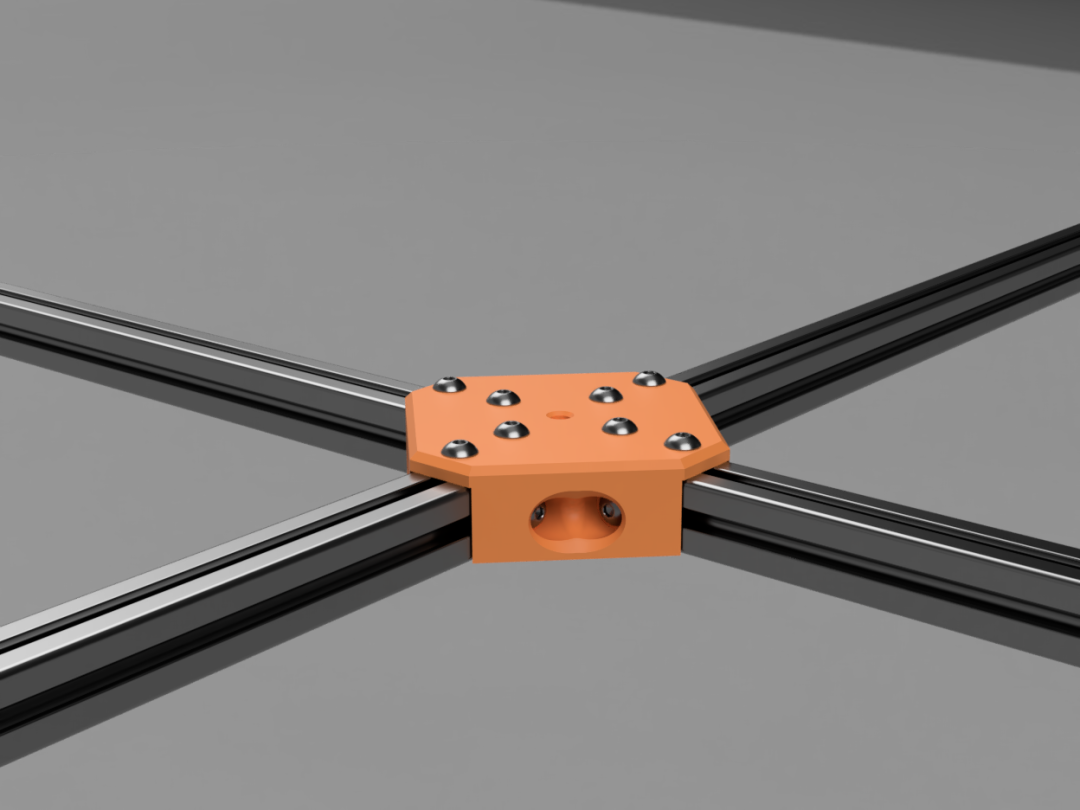
A 4-way tee for 2020 aluminum t-slot extrusions. Provides sturdy corner for bringing 4 extrusions to a square corner.
Each one takes about an hour and a half with my slice settings (0.48 layers on a 0.6 nozzle, full settings in the attached 3mf file.)
Corners
Square Corner
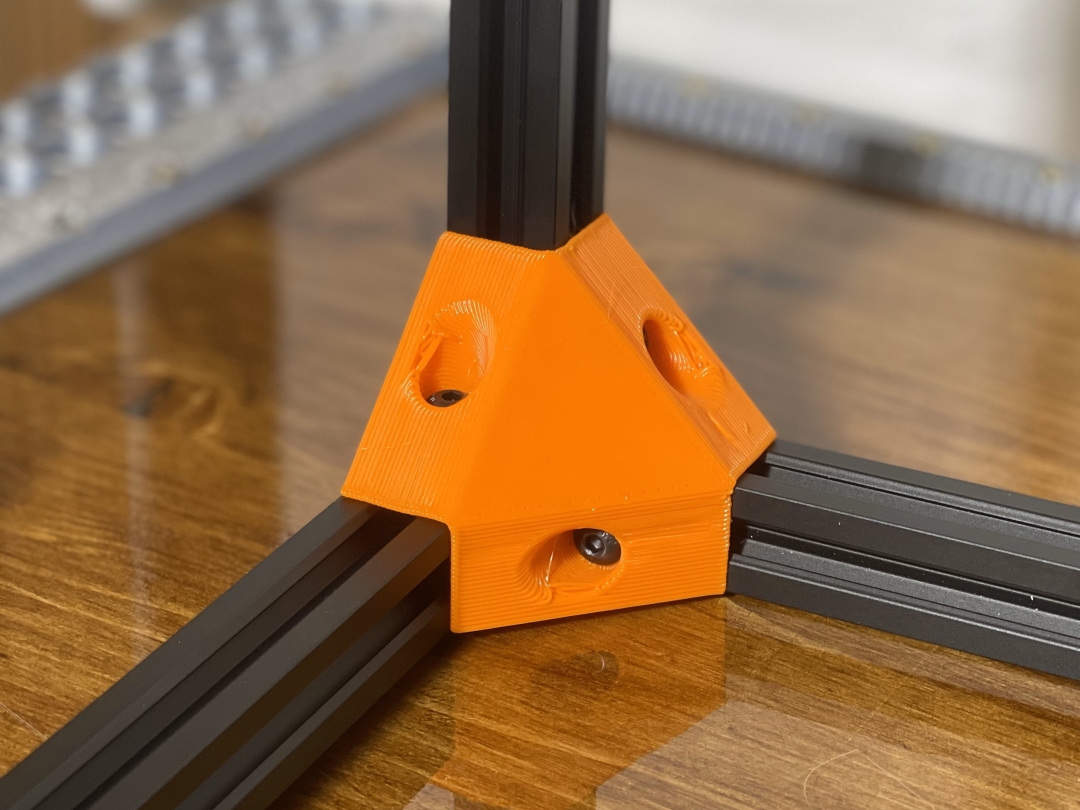 |
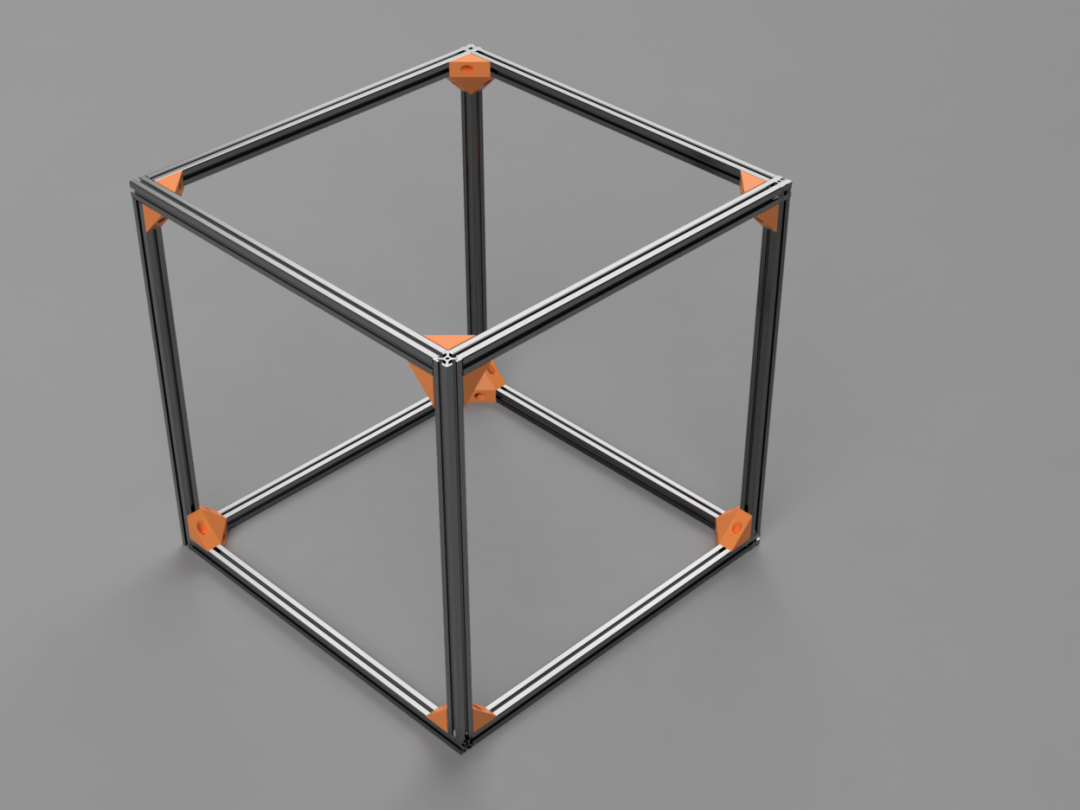 |
Designed to fasten 2020 Aluminum Extrusions to make cubes with flush edges. Not intended to be particularly high load capacity, but I've built quite a few frames from this general design, and they are working just fine for my needs! Holes are designed for M5x16 BHCS fasteners, but slightly shorter (maybe down to 12mm...maybe...?) should work.
Mine have printed fine without supports, brims, etc.
I printed these in Orange Overture PETG with 0.48 layers on a 0.6mm Revo nozzle.
Other Stuff
PSU to 2020 Mount
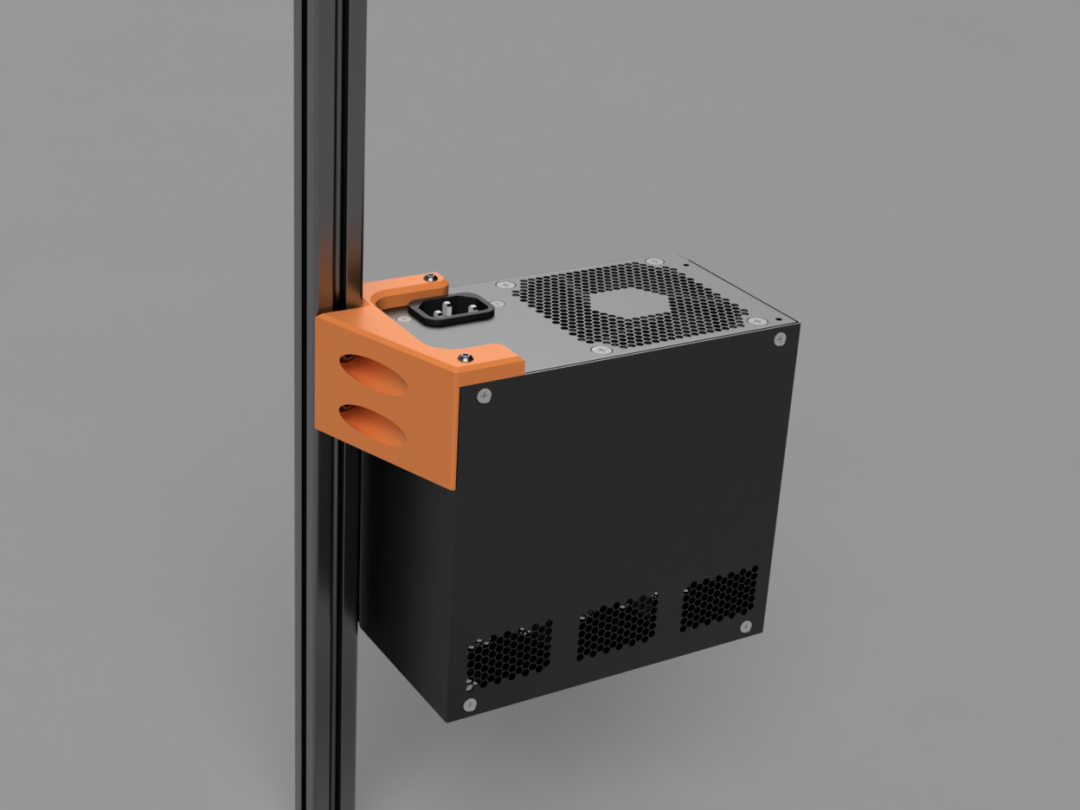 |
 |
A bracket for attaching an ATX (regular ol' computer power supply) to 2020 extrusion, but please note, although I show it suspended in a vertical orientation with just this bracket, I wouldn't recommend it! This was designed, and is currently used, with an additional support below the supply. This bracket will support the weight of the supply by itself, but my concern is whether that would stay stable long term, after exposure to heat from the PSU.
Should print fine without supports, brims, etc.
I printed the one shown with 0.48mm layers out of Black Overture PETG.
Waste Bin
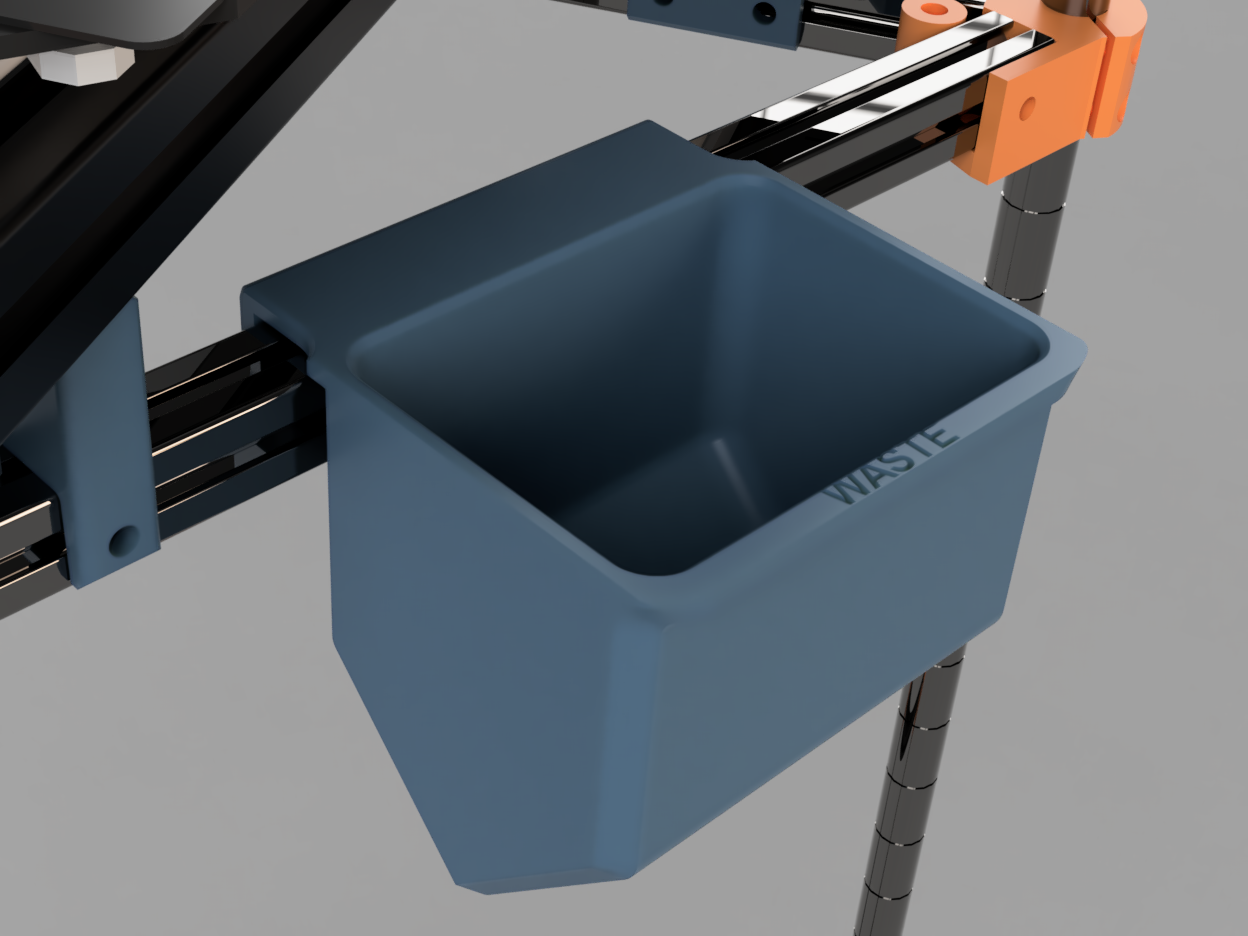 |
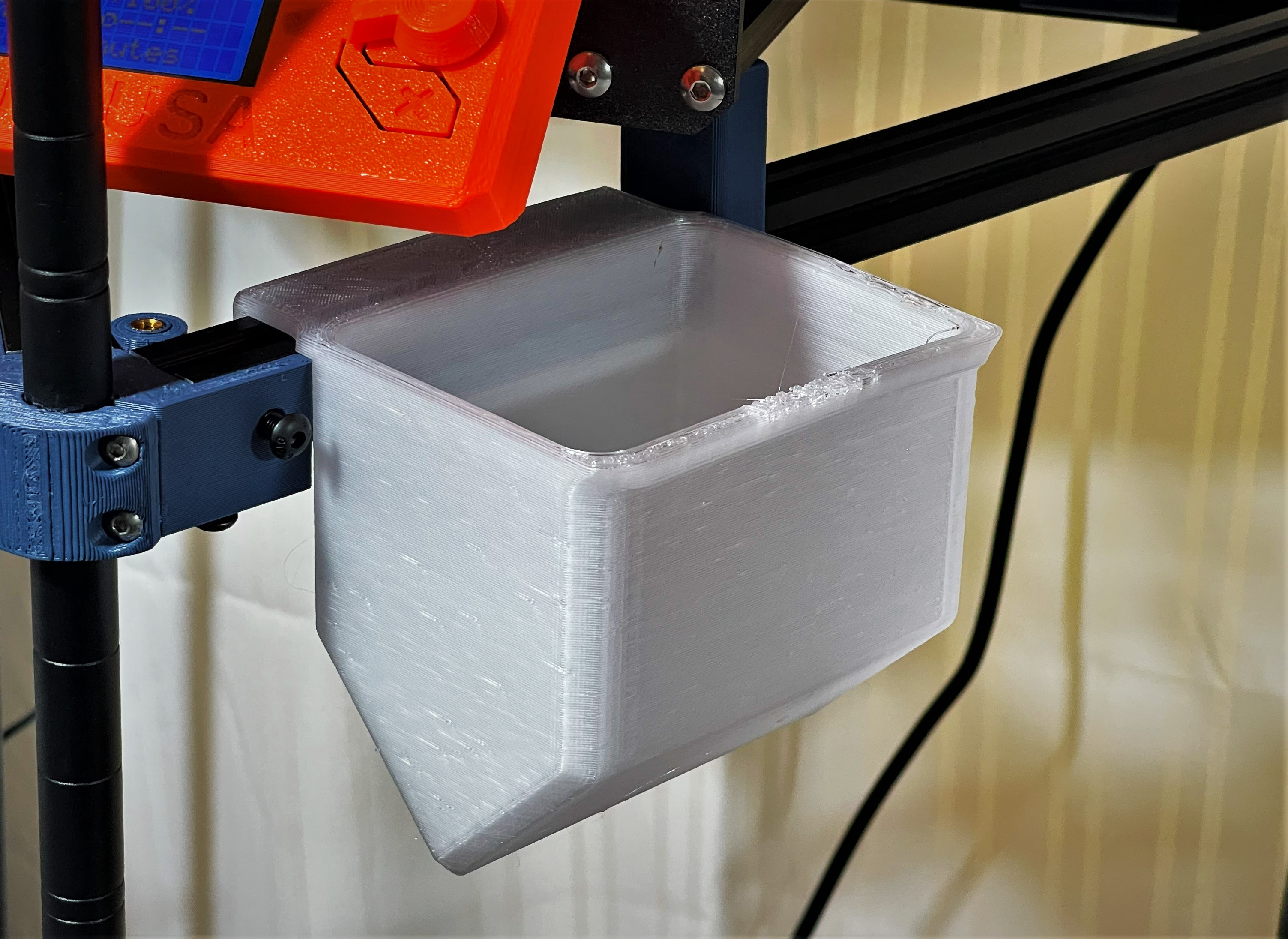 |
A simple waste bin that hangs from 2020 extrusion, intended as a convenient spot for tossing purge lines, brims, and the other assorted scraps/trash that accompany extrusion printing.
Prints without supports and took about 3.5 hours with the attached slicer config (0.6 nozzle), but I should point out that the lettering on my print came outa little lackluster.
I printed mine in Overture clear PETG
Simple Hook
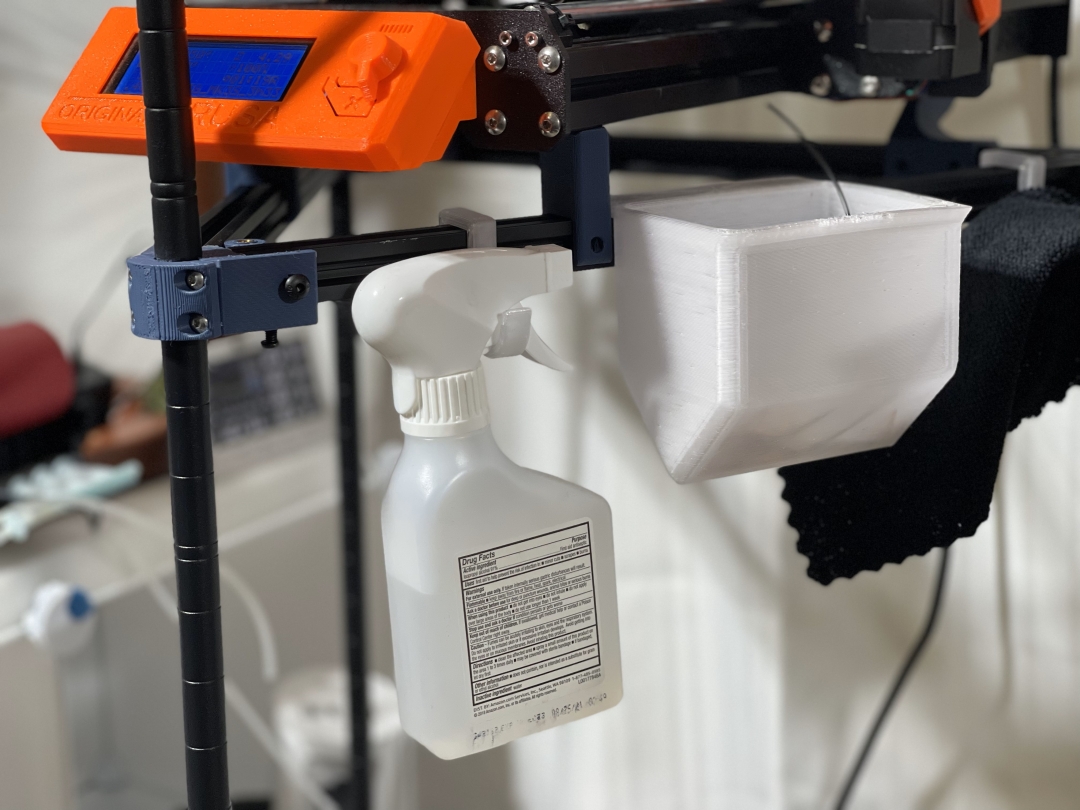
A simple, quick-printing hook for hanging accessories and such from 2020 extrusions. I'm using several of them quite happily on my i3 printer tower.
- Details
- Parent Category: BubsBuilds Projects
- Category: Assorted (hopefully) "Useful Stuff" Projects
Baoding Ball Stand
Small (sized for ball measured at 40mm diameter)
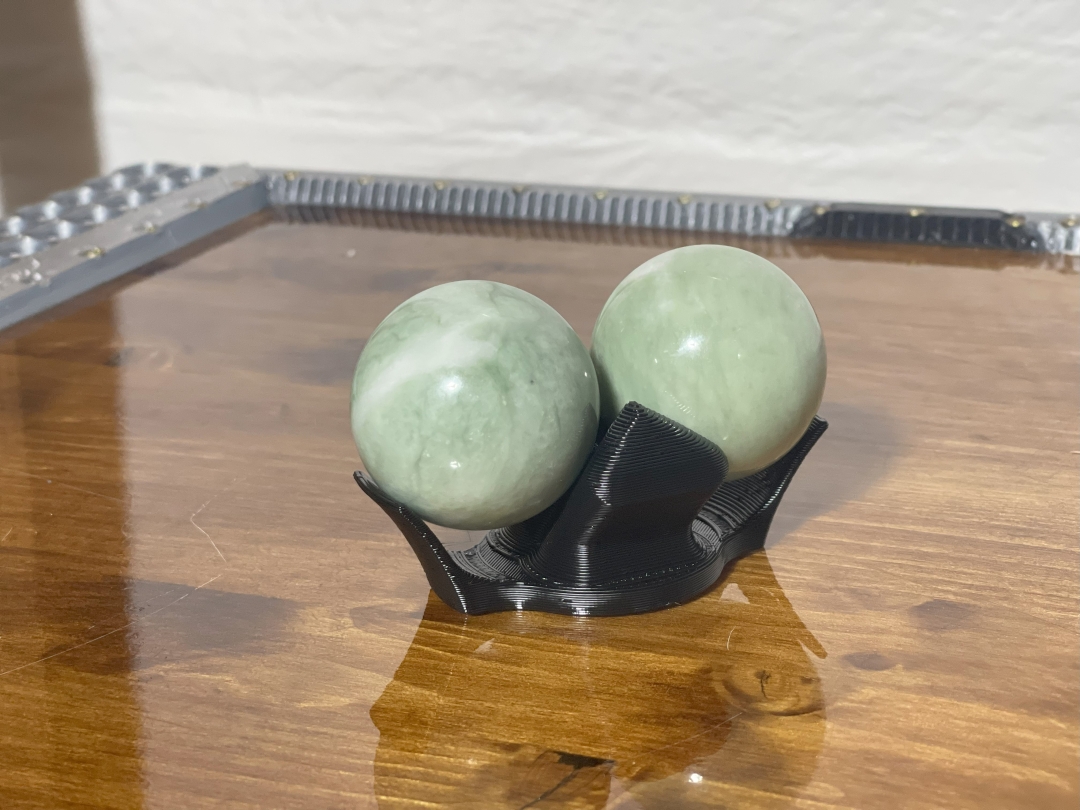
A little desk stand for small Baoding balls (or meditation balls, stress balls, etc.). I designed it based on 40mm diameter balls (the black ones in the pictures), but the green balls in the pictures are 48mm diameter and still fit well enough for me.
Should print fine with no supports, brims, etc. I printed mine in PETG at 0.48 layers....I tend toward quick and 'pretty enough' :)
The stand pictured was printed in Black Overture PETG. You can find the slicer files and such here on Printables. If you like the look of those balls...I honestly am having trouble containing my 12 yr old self constantly on this one....they are these "Greenish" ones. I partially bought them just because I love that they actually called them "Greenish"
Large (sized for balls measured at 51mm diameter)
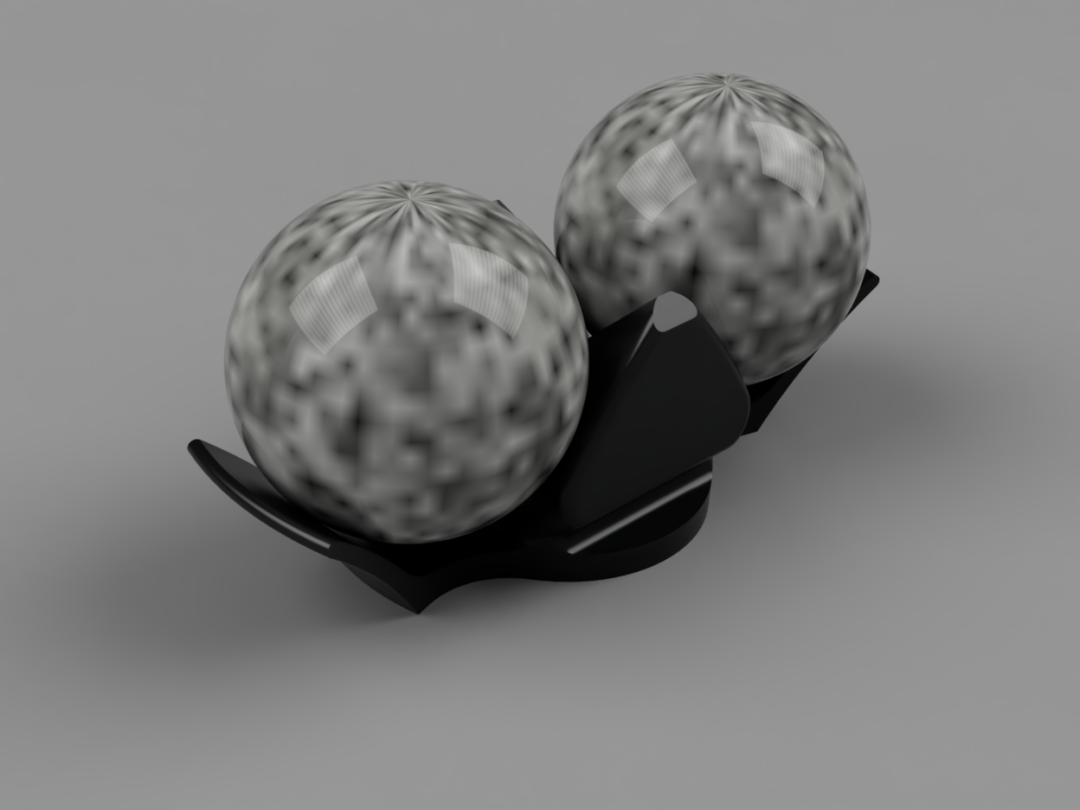
This one is pretty much the same as the one above, but was sized for the larger, 51mm (2") diameter balls. I did also slightly modify the profile on the sides, so there is a slight aesthetic difference I suppose.
Caliper Stands:
Generative Design Caliper Stand
- Details
- Parent Category: BubsBuilds Projects
- Category: Assorted (hopefully) "Useful Stuff" Projects
Simple Hook for Wire Shelving

Just a simple hook for hanging cables and similar items in need of hanging. The flat in the middle is sized for a standard label-maker label.
Simple Hook for 2020 Extrusion

A simple, quick-printing hook for hanging accessories and such from 2020 extrusions. I'm using several of them quite happily on my i3 printer tower.
- Assorted Frame-making Hardware
- P&L Flipper Billiards
- Prusa Bed Camera Mount
- Generative Design Caliper Stand
- Generative Design SD Card (and Guitar pick, it turns out) Holder
- HydroHub - 4 in / 4 out distribution hub
- High Flow Peristaltic Pump
- Precision Dosing Pump
- Stackable/Modular Peristaltic Pump Concept
- Initial/Manual Pump
Subcategories
Assorted (hopefully) "Useful Stuff" Projects Article Count: 12
Like the bucket of assorted fasteners on that bottom shelf, this category is for stuff that I didn't know how to group...oh, and speaking of those fasteners, check out the little sortin fella!
2020 Aluminum Extrusion Hardware
|
Quick Bolt Sorter
|
General Purpose Turntable - Gen1
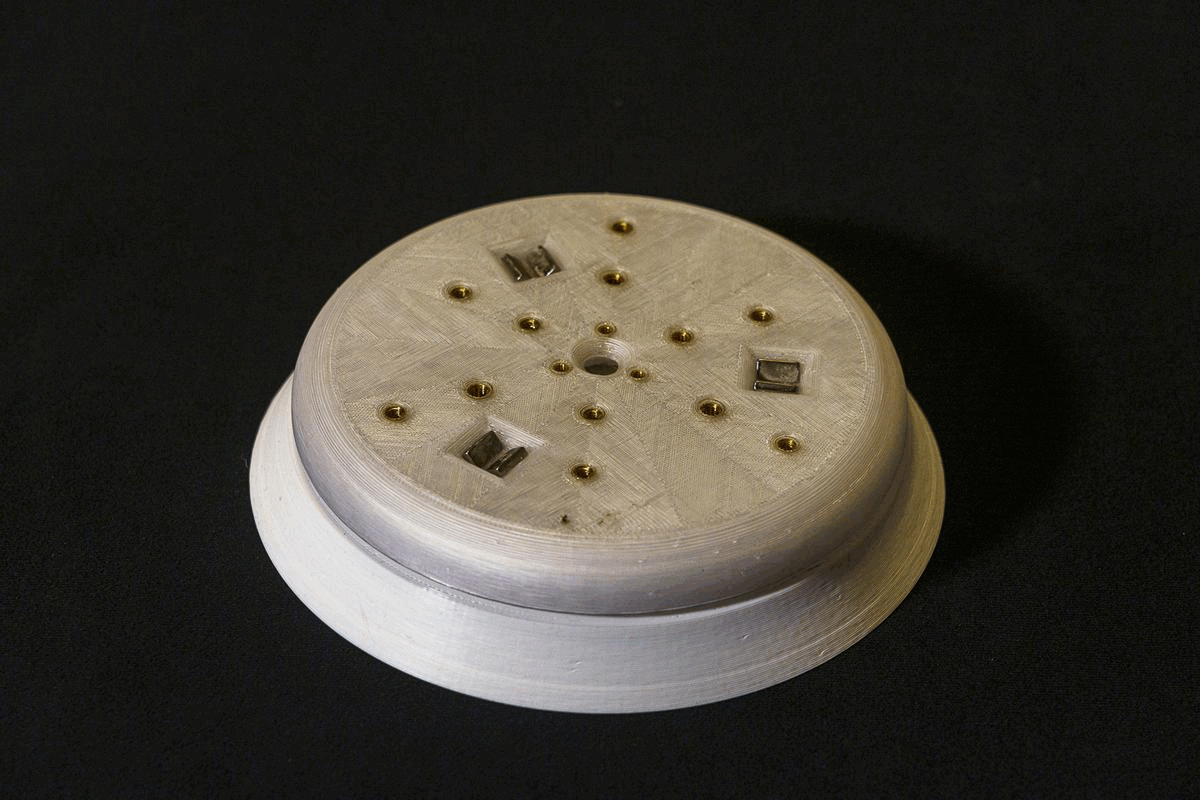
Games Article Count: 1
Generative Design Projects Article Count: 3
During the good financial decision-making times of Covid lockdowns, etc. I decided it was a good idea to buy a license for the Fusion360 Generative Design extension...Good news, I did finally pay that off :) I had worked around, and been somewhat involved in a handful of Topology Optimization/Generative Design projects through my work, and I've found the tech super interesting for some time. So after the free trial, and feeling like I was just starting to gain some level of competence in Fusion360's tool....I done did it, and bought the year. Ok, now that I'm done justifying that to myself...I mean you...
<engineering/design> What I really like about Generative Design is that it forces the designer to think about the thing they are trying to design from it's core requirements: Forces, Interfaces, and Keep Outs. I think it's far from perfect, especially given the still very primitive Design For Manufacture capabilities these tools have (among other shortcomings, but this one is certainly a big one to me.)
<precision engineering> One last also (for now), but ALSO, what I find exciting about these tools from a precision engineering perspective, is that the above-mentioned focus on forces and interfaces, these tools are extremely well-suited to kinematic/exact constraint designs! I think every one of the Generative Design projects below features at least some aspects of kinematic constraint (I say, "I think" because I may or may not be writing this before I go through my files and remind myself what all I actually made vs what I just thought about making ¯\_(ツ)_/¯ )
JFS Projects Article Count: 14
AgTech (aka finding a way to complicate and digitize gardening) Projects Article Count: 12
Hydration and Hydroponics Projects Article Count: 8
Peristaltic Pumpin Article Count: 4
A lot of projects I work on/have worked on seem to involve the controlled movement of fluids. Below is a bit of a history of my builds involving attempts at obtaining this controlled movement for incompressible fluids. I haven’t done much myself with making custom solutions for the compressible stuff, but if you’re interested in such things, I thoroughly enjoy Major Hardware’s “Fan Showdown” series :)
This article/section is by no means intended as a thorough overview on the design and operation of pumps. While I will try to give some overview on operating principles and design considerations as I go, this is mainly just going to be a wander through my personal builds and experiences.
Peristaltic Pumps
What is a peristaltic pump?
I’m sure there are innumerable sources online for (much better) detailed discussions of the workings of peristaltic pumps. So I’m just going to hit the highlights, and I’ll try to remember to find some promising links and add them below, should a deep dive seem intriguing to ya.
Basic Operation:
The fluid being pumped is carried into the pump in a compliant tubing. This tube is routed around some portion of a circular/cylindrical path around the axis of the pump and then exits the pump. This is one interesting/attractive aspect of peristaltic pumps, the fluid never has to leave the tube that it is in, making these pumps well-suited to situations where contamination and/or leaks are highly undesirable. The housing that features the cylindrical wall that the tubing is being routed along can be considered the Stator, and that is generally the nomenclature that I tend to use.

So if there’s a Stator, there must be a Rotor…? Yup, the rotor includes some set of features that extend out to some defined gap between this feature and the Stator wall. These features, which in many peristaltic pumps are rolling element bearings, pinch the tubing to the point of sealing (ideally) the tube. As the rotor turns, this contact point proceeds around the circumference. Because the pinched point of the tube is sealed, the volume of fluid in the tube ‘ahead’ of the pinch point are, as a result, pushed forward. So, keep rotating, keep pushing….pretty much as simple as that!
Pros:
- Positive Displacement Pump
- Because the pinch point is (ideally) fully sealing the tubing, the amount of fluid moved is directly proportional to the movement of the pump. This makes them very good choices for things like dosing pumps or other applications where the desired volume of fluid to be moved needs to be deterministic.
- This is a large driver for my initial interest in using peristaltic pumps. Their deterministic flow is/was very attractive for my plant growth experiments. They can give very repeatable watering volumes and nutrient concentrations.
- Fluid Isolation
- Because the fluid never leaves the tubing, these pumps can be suitable for moving hazardous materials. For example, I have been using a peristaltic pump for transferring 99% IPA
- Relatively Simple Construction
- Because the fluid does not have to be sealed within the pump, these pumps lend themselves well to DIY builds. No shaft seals, gaskets, etc. or complex (at least to do well) impeller design needed.
- Self-priming and Head height
- If well-sealed, these pumps are capable of self-priming (and even pumping air) and of achieving pretty impressive head heights (the measure of how high above the pump it can pump a column of water)
Cons:
- High drive torque
- Because of the preloading needed against the tubing, and the rolling friction, even with good rolling elements (more below on this), it can be quite easy to end up with designs that require quite a lot of drive toque.
- Tubing wear
- With the relatively large deformation and high number of cycles, the tubing will eventually fail, either due to material wear, fatigue cracking, or who knows what else. Because this failure mode can cause fluids leaking into your pump not designed to experience this fluid, this failure can potentially be quite problematic. So the use of high-quality tubing material and a plan for periodic maintenance, are worthwhile.
Test Build 1
A couple of years back, I had a concept for an in-line-mixing hydroponics system. The idea being that the supplies to the system would be just pure water and nutrient concentrates, and a series of pumps and valves would allow precise dosing mixes to each target plant in a system (I refer to this concept as Rail Yard Hydro, since it moves the fluids around the tubing network quite like rail cars are moved around a rail system. I’m planning to add a separate page diving into that one a bit deeper since it is the design scheme I am using in my current projects.)
Well, to facilitate this plan, I wanted to find an option for a dosing pump that I could integrate in to my control system (aka Arduinos and Raspberry Pi’s :)). Unfortunately, I quickly found that a servo-driven peristaltic pump could easily set me back north of $100….so I set out to spend many multiples of that making my own!
Actually, when I saw the pricing, I decided I should see if I could make myself a cheapo, manual version that I could use to just test out some basic questions on the Rail Hydro idea (mainly verifying that I could induce good material mixing in-line and that there was no cross-contamination between fluid reservoirs.) And so, ‘twas this endeavor that resulted in the pump I’m apparently referring to as “Test Build 1”
Design Objectives:
- Be a peristaltic pump
- Provide a full seal (at 100mm head)
- Be hand-cranked
- Not require any parts that would have to be ordered (I’m impatient)
The Build
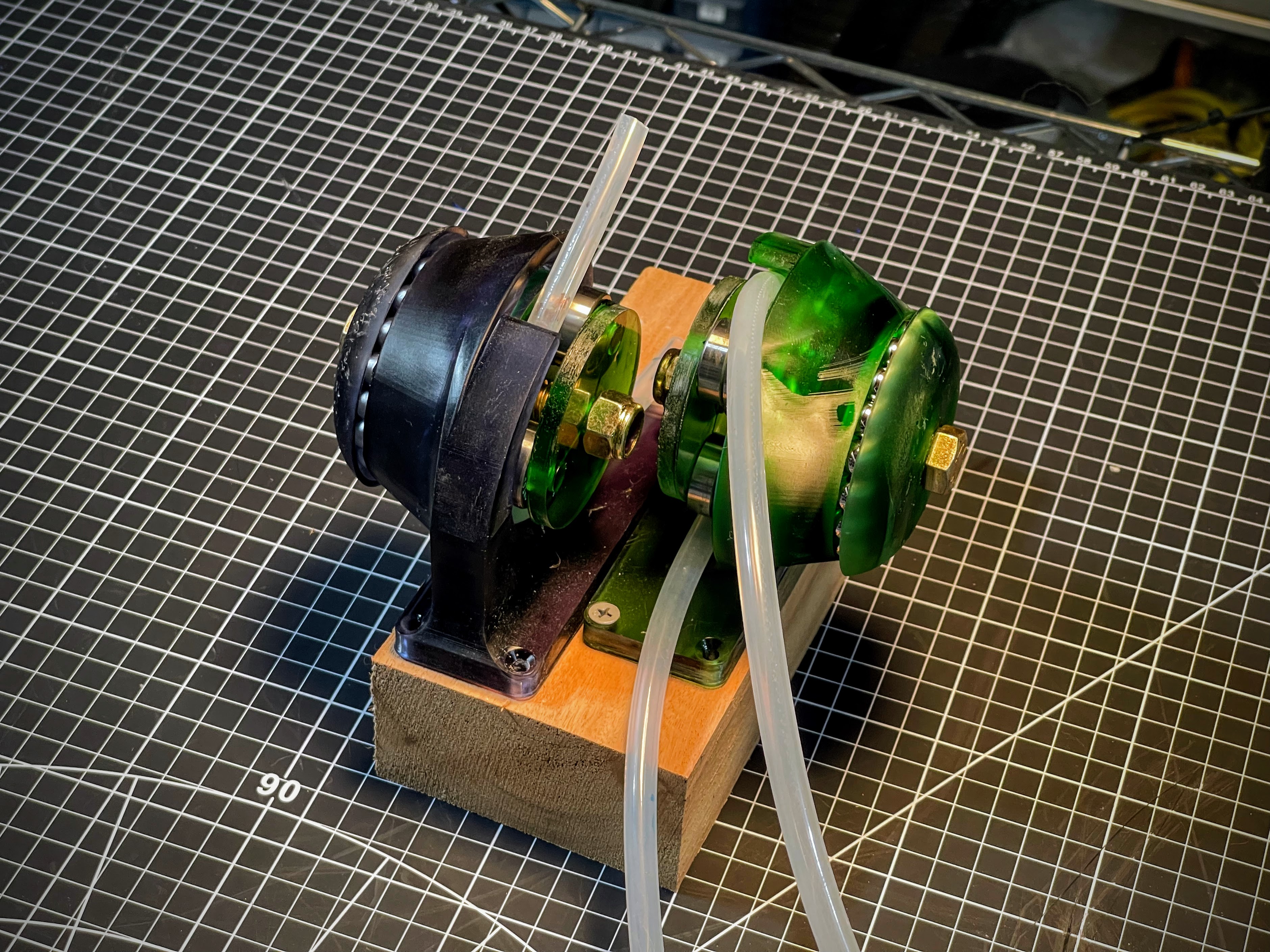
She ain't pretty (especially after a good while of getting knocked around), but the pic above shows the dual pump setup I rigged up for my testing needs. I was VERY pleasantly surprised that, other than a tweak to the hand wheel, these things worked pretty damn well!

I decided upfront that I was going to go with a resin printed build, because I thought the high stiffness and good surface finish throughout the 'pinch region' would give me a better chance. Since I was already going to have the good surface roughness, I might as well also integrate the main bearing into the printed parts.
In the image of the model, below, the Stator is the part shown in green, and the Rotor is shown in blue(ish.) Riding on the rotor are roller skate bearings to provide the contact with the tube. Race 1 has v-grooves on both sides of the race, providing the main constraint for locating the rotor, and Race 2 has a v-groove on the Stator, but only a single plane of contact on the Rotor side. This keeps from over-constraining the bearing.
 |
 |
The absurdly overkill bolt running through the center is a real showcase of "using what I had on hand" :) in that these were the only bolt/nut sets I had on hand with the length I was looking for.
